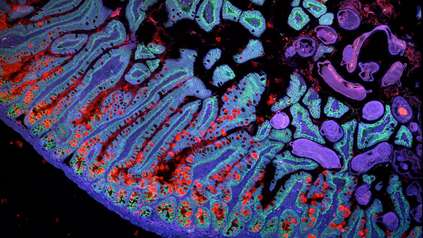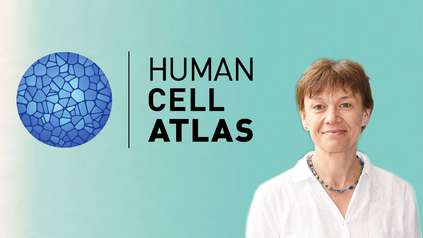Highly detailed map of human heart could guide personalised heart treatments
Scientists have created a cellular and molecular map of the healthy human heart, to understand how this vital organ functions, and to shed light on what goes wrong in cardiovascular disease.
Researchers from the Wellcome Sanger Institute, Max Delbrück Center for Molecular Medicine (MDC), Germany, Harvard Medical School, Imperial College London and their global collaborators analysed almost half a million individual cells to build a first extensive draft cell atlas of the human heart. The atlas shows the huge diversity of cells and reveals heart muscle cell types, cardiac protective immune cells, and the intricate network of blood vessels. It also predicts how the cells communicate to keep the heart working.
Published today in Nature (24 September), this study is part of the Human Cell Atlas initiative to map every cell type in the human body. The new molecular and cellular knowledge of the heart will enable better understanding of heart disease and guide more personalised medicine. It could also potentially lead to regenerative medicine in the future.
The heart is an essential organ that pumps blood around the body, enabling oxygen and nutrients to be delivered and carbon dioxide and waste products to be carried away from other vital organs and tissues. Each day, the heart beats around 100,000 times with a one-way flow through four different chambers, varying speed with rest, exercise and stress. This is extremely complex and needs the cells in each part of the heart to coordinate with each other for every heartbeat.
Cardiovascular disease is the leading cause of death worldwide, killing an estimated 17.9 million people each year, with heart attacks and strokes causing the majority of these. To understand what happens during heart disease and create better therapeutic strategies, it is vital to know the intricate molecular processes in the cells of the healthy heart.

In this new study, researchers studied nearly 500,000 individual cells and cell nuclei from six different regions of healthy hearts from 14 organ donors*. Using cutting edge, single cell technology, machine learning and imaging techniques, the team could see exactly which genes were switched on in each cell.
The researchers discovered that there were major differences in the cells in different areas of the heart, and that each area of the heart had specific sets of cells, highlighting different developmental origins and potentially different responses to treatments.
“We have created the most detailed atlas of the human adult heart to date combining single cell technologies with artificial intelligence methods, to characterise almost half a million single cells. For the first time, we could see exactly what each cell is doing in the human heart. This atlas shows that the cells in each of the four chambers of the heart behave differently to each other, mirroring the different functions of each area and helping us understand the healthy human heart.”
Dr Carlos Talavera-López, one of the first authors from the Wellcome Sanger Institute, and previously at the EMBL European Bioinformatics Institute
The six areas of the heart contained 11 different cell types and the researchers discovered more than 62 different cell states, which had never been seen before in this detail.
“This is the first time anyone has looked at the single cells of the human heart at this scale, which has only become possible with large-scale single cell sequencing. This study shows the power of single-cell genomics and international collaboration. Knowledge of the full range of cardiac cells and their gene activity is a fundamental necessity to understand how the heart functions and start to unravel how it responds to stress and disease.”
Professor Norbert Hübner, a senior author from Max Delbrück Center for Molecular Medicine, Charité – Universitätsmedizin Berlin, the Berlin Institute of Health and Deutsches Zentrum für Herz-Kreislauf-Forschung, Germany
As part of this study, the researchers studied the blood vessels running through the heart in unprecedented detail. The atlas showed how the cells in these veins and arteries are adapted to the different pressures and locations, and could help understand what goes wrong in the blood vessels during coronary heart disease.
“Our international effort provides an invaluable set of information to the scientific community by illuminating the cellular and molecular details of cardiac cells that work together to pump blood around the body. We mapped the cardiac cells that can be potentially infected by SARS-CoV-2 and found that specialized cells of the small blood vessels are also virus targets. Our datasets are a goldmine of information to understand subtleties of heart disease.”
Dr Michela Noseda, a senior author from the National Heart and Lung Institute, Imperial College London
“Millions of people are undergoing treatments for cardiovascular diseases. Understanding the healthy heart will help us understand interactions between cell types and cell states that can allow lifelong function and how these differ in diseases. Ultimately, these fundamental insights may suggest specific targets that can lead to individualised therapies in the future, creating personalized medicines for heart disease and improving the effectiveness of treatments for each patient.”
Professor Christine Seidman, a senior author from Brigham and Women’s Hospital, Harvard Medical School and Howard Hughes Medical Institute
The researchers also focused on understanding cardiac repair, looking at how the immune cells interact and communicate with other cells in the healthy heart, and how this differs from skeletal muscle. Further research will include investigating if any heart cells could be induced to repair themselves.
“This great collaborative effort is part of the global Human Cell Atlas initiative to create a ‘Google-map’ of the human body. Openly available to researchers worldwide, the Heart Cell Atlas is a fantastic resource, which will lead to new understanding of heart health and disease, new treatments and potentially even finding ways of regenerating damaged heart tissue.”
Dr Sarah Teichmann, a senior author from the Wellcome Sanger Institute and co-chair of the Human Cell Atlas Organising Committee
More information
*Hearts were donated from 14 organ donors whose hearts were healthy but not suitable for organ transplantation for a number of reasons. We are grateful to the deceased donors and their families for their invaluable gift. All data from this study can be explored at: www.heartcellatlas.org
WHO statistics on cardiovascular disease: https://www.who.int/health-topics/cardiovascular-diseases
How the heart works: BHF – https://www.bhf.org.uk/informationsupport/how-a-healthy-heart-works
Publication:
Monika Litviňuková , Carlos Talavera-López , Henrike Maatz & Daniel Reichart et al. (2020) Cells of the adult human heart. Nature. DOI: 10.1038/s41586-020-2797-4
Funding:
This study was supported by the British Heart Foundation (BHF), European Research Council, the Federal Ministry of Education and Research of Germany, Deutsches Zentrum für Herz-Kreislaufforschung e.V. (DZHK), the Leducq Fondation, the German Research Foundation (DFG), Chinese Council Scholarship(CSC), the Alexander von Humboldt Foundation, EMBO, CIHR Canadian Institutes for Health Research, HSF Heart and Stroke Foundation, AI Alberta Innovates, the Chan Zuckerberg Initiative, the Wellcome Sanger Institute, Wellcome, NIH and the Howard Hughes Medical Institute.
Selected websites
Max Delbrück Center for Molecular Medicine (MDC), Berlin, Germany
The Max Delbrück Center for Molecular Medicine in the Helmholtz Association (MDC) was founded in Berlin in 1992. It is named for the German-American physicist Max Delbrück, who was awarded the 1969 Nobel Prize in Physiology and Medicine. The MDC’s mission is to study molecular mechanisms in order to understand the origins of disease and thus be able to diagnose, prevent, and fight it better and more effectively. In these efforts the MDC cooperates with Charité – Universitätsmedizin Berlin and the Berlin Institute of Health (BIH) as well as with national partners such as the German Center for Cardiovascular Research (DZHK) and numerous international research institutions. More than 1,600 staff and guests from nearly 60 countries work at the MDC, just under 1,300 of them in scientific research. The MDC is funded by the German Federal Ministry of Education and Research (90 percent) and the State of Berlin (10 percent), and is a member of the Helmholtz Association of German Research Centers. www.mdc-berlin.de
About Harvard Medical School
Harvard Medical School has more than 11,000 faculty working in the 11 basic and social science departments comprising the Blavatnik Institute and at the 15 Harvard-affiliated teaching hospitals and research institutes: Beth Israel Deaconess Medical Center, Boston Children’s Hospital, Brigham and Women’s Hospital, Cambridge Health Alliance, Dana-Farber Cancer Institute, Harvard Pilgrim Health Care Institute, Hebrew SeniorLife, Joslin Diabetes Center, Judge Baker Children’s Center, Massachusetts Eye and Ear/Schepens Eye Research Institute, Massachusetts General Hospital, McLean Hospital, Mount Auburn Hospital, Spaulding Rehabilitation Network and VA Boston Healthcare System.
About Imperial College London
Imperial College London is one of the world’s leading universities. The College’s 17,000 students and 8,000 staff are expanding the frontiers of knowledge in science, medicine, engineering and business, and translating their discoveries into benefits for our society.Imperial is the UK’s most international university, according to Times Higher Education, with academic ties to more than 150 countries. Reuters named the College as the UK’s most innovative university because of its exceptional entrepreneurial culture and ties to industry.
The Wellcome Sanger Institute
The Wellcome Sanger Institute is a world leading genomics research centre. We undertake large-scale research that forms the foundations of knowledge in biology and medicine. We are open and collaborative; our data, results, tools and technologies are shared across the globe to advance science. Our ambition is vast – we take on projects that are not possible anywhere else. We use the power of genome sequencing to understand and harness the information in DNA. Funded by Wellcome, we have the freedom and support to push the boundaries of genomics. Our findings are used to improve health and to understand life on Earth. Find out more at www.sanger.ac.uk or follow us on Twitter, Facebook, LinkedIn and on our Blog.
About Wellcome
Wellcome exists to improve health by helping great ideas to thrive. We support researchers, we take on big health challenges, we campaign for better science, and we help everyone get involved with science and health research. We are a politically and financially independent foundation.





